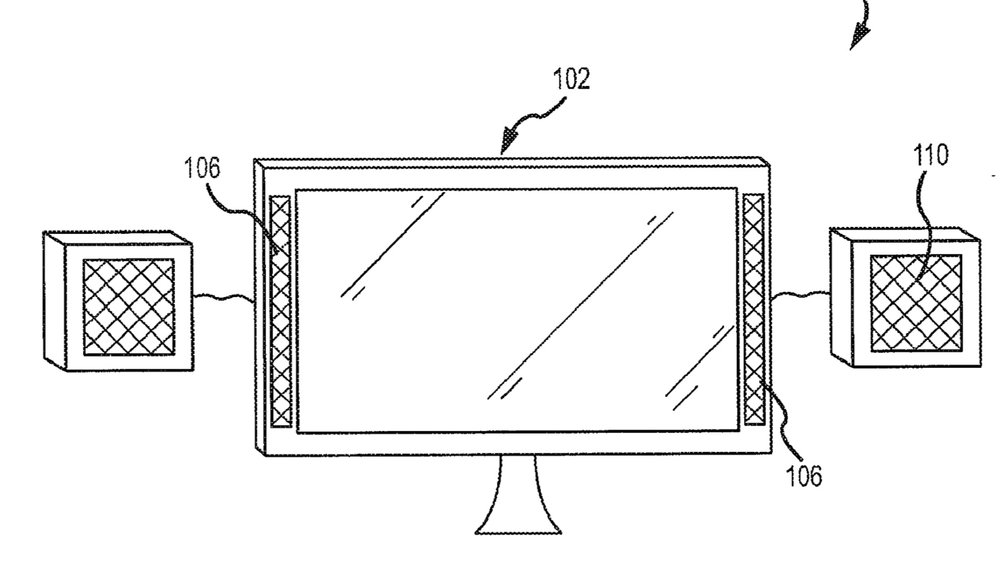Future Macs may adjust their audio depending on where you’re sitting or standing — and based on how many folks are in a room. Apple has filed for a patent (number 20170249122) for “devices with enhanced audio.”
The patent involves a system for enhancing audio including a Mac and an output device. The Mac includes a sensor configured to determine a user location relative to the computer. The sensor is also configured to gather environment data corresponding to an environment of the computer.

The Mac also includes a processor in communication with the sensor and configured to process the user location and the environment data and adjust at least one of an audio output or a video output. The output device is in communication with the processor and is configured to output at least one of the audio output or the video output.
In other words, the system may rely on sensors and imaging devices to interpolate user inputs so that the user doesn’t have to physically enter them. This would allow for an audio output device to dynamically adjust to different user parameters to enhance the audio output without requiring active inputs from the user directly.
In one embodiment, the system may enhance the audio output for a video conferencing or chat. During video conferencing, the user on the receiving end may have a difficult time determining what each person is saying, especially if there are multiple people talking at a single time.
The system may capture images of the different users (e.g., via a video camera) and the receiving user may be able to enhance the audio for a particular user. For example, the receiving user may tap on the image of the particular user (or otherwise select or indicate the user) upon whom he or she wishes the embodiment to focus, and the system may digitally enhance the audio as well as steer a microphone towards the user in order to better capture the user’s audio input.
In one example, the system may include a computer having multiple microphones spaced around a perimeter of a display screen, and the particular microphones may be turned on/off as well as rotated in order to best capture a desired audio signal.
Similarly, the system may also be configured to direct a microphone, enhance the audio and/or focus the video image on a person that is speaking. Mouth tracking or speech recognition may be used to focus the audio and/or video on a particular user that is speaking.
This may allow a user receiving an audio data stream to better be able to hear the user speaking (e.g., the transmitting user of the system). Thus, the enhancement feature of either or both of the audio or video images of a user may be automatic (e.g., based on mouth tracking or speech recognition) or may be based on user input (e.g., a user can select a user or focus area).
Output audio quality may depend, at least partially, on the environment. For example, echo cancellation may be desired and/or affected by the size and acoustics of the room. Two factors that may affect the quality of output audio may include room dimension and reverberant qualities.

According to Apple, its system may be configured to adjust the audio output depending a user’s location with respect to the audio output device, the user’s position (e.g., facing head-on or turned away) with respect to the audio output device, and environmental inputs (such as the size of the room, reverberation of the room, temperature, and the like).
The user’s inputs may include his or her location within a room, whether he or she is facing the audio output device, etc. What’s more, the system may vary the audio output not only based on the user and environmental inputs, but also the current application that the computer or audio output device may be running. For example, if the application is a telephone call the response may be varied as compared with a music player application.
According to the patent, the system may include video, audio, and environmental sensors. For example, image sensors (e.g., cameras) and depth sensors (ultrasonic, infrared, radio frequency and so on) may be used. Additionally, the desired output may also be changed based on a user location to the Mac, e.g., if a user is far away from the computer in a large room versus if a user is close to the computer in small room.
For example, if an object is presented in a video as being positioned far away from the user, the output audio of the particular object (or user) may be varied in order to sound to the user as though the object is far away. In this implementation, depth may be provided to local audio of a far-field image in order to enhance the overall audio/visual experience of the user.
In still other embodiments, the system may be configured to adjust an output audio based on the user. Men, women, and children may all have different hearing spectrums, generally women may hear better than men and children may hear better than either men or women adults. The system may utilize speech or facial recognition or other gender identifying techniques in order to vary the output audio depending on the particular user.
Of course, Apple files for — and is granted — lots of patents by the U.S. Patent & Trademark Office. Many are for inventions that never see the light of day. However, you never can tell which ones will materialize in a real product.
